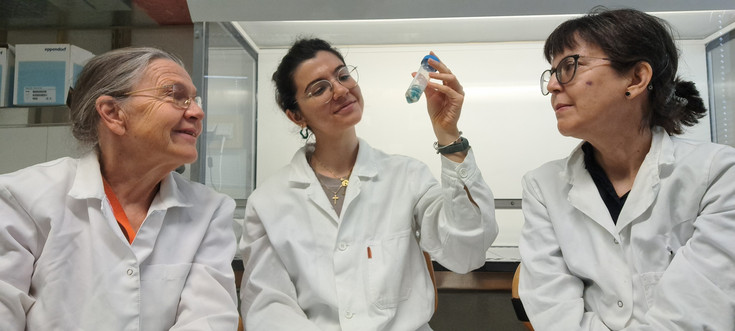08.07.2024 - A special kind of anniversary: once blue, always blue

Margit Laimer, Patricia Burillo Cartagena and Eduviges Borroto Fernandez watching the plant tissues transformed 30 years ago. (c) PBU
30 years of stability of the expression of an inserted gene (GUS) in cherry rootstocks shows high reliability for breeding
By chance, researchers at PBU have come across an interesting discovery. The study conducted by Prof. Dr Margit. Laimer and Dr Eduviges Borroto Fernandez, Spanish Master's student Patricia Burillo Cartagena, MSc. is currently carrying out transformation experiments in olives to generate resistance to the bacterium Xylella fastidiosa. To demonstrate successful transformation with a marker gene, suitable plant tissue was required as a positive control.
At the PBU, the transgenic cherry lines with the GUS reporter gene, which the researchers regenerated three decades ago at the beginning of the transformation work - at that time to generate virus resistance in stone fruit - and have since maintained in vitro, were suitable for this purpose. It has now been shown that the ability to blue colour has been preserved over all this time.
"The fact that the blue colouring ability has been maintained over 30 years means that the inserted gene behaves like a plant's own gene, which offers a high degree of reliability for breeding efforts," says Margit Laimer.
The GUS reporter system (GUS: β-glucuronidase) is a reporter gene system in plant molecular biology. The technique utilizes the uidA gene of Escherichia coli, which codes for the enzyme, β-glucuronidase; this enzyme, when incubated with specific colorless or non-fluorescent substrates, can convert them into stable colored or fluorescent products. The most common substrate for GUS histochemical staining is 5-bromo-4-chloro-3-indolyl glucuronide (X-Gluc). X-Gluc is hydrolyzed by GUS into the product 5,5'-dibromo-4,4'-dichloro-indigo (diX-indigo). The presence of the GUS-induced color DiX-indigo indicates if and where the gene has been actively expressed.
In 1994 the PBU succeeded for the first time in introducing marker genes (uidA and nptII) into cherries and demonstrating their function in the plant tissues. Starting from an embryogenic callus of Prunus subhirtella, the scientists were able to regenerate entire plants via somatic embryos, in whose tissue the gene led to an expression-dependent blue coloration of varying intensity.
This material has allowed to study interesting aspects in relation to duration but also to stress response in expression levels of introduced genes and to publish several peer reviewed papers.
Fortunately, the transformation attempts with olives also led to a positive result, which contributed to a particularly successful conclusion to the Master thesis of the master student Patricia Burillo Cartagena.
